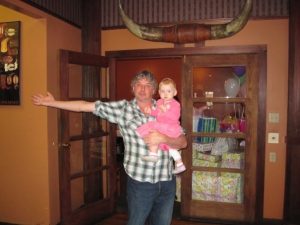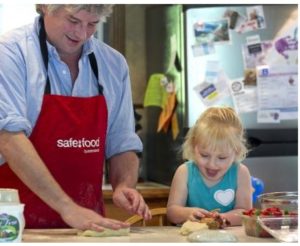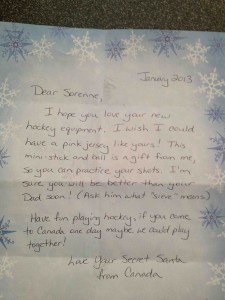I love this picture that Amy, the team manager took of Sorenne.
My health woes have kept me away from the rink, but Sorenne and Amy are stepping up in fine form.

There’s been some changes in technical stuff at barfblog.com, and I don’t really understand what’s going on, I just write for free to delay the inevitable decay of my brain.
If you want to follow us on facebook, you need to sign up to the barfblog group, because that’s where the postings show up.
I don’t know if subscribers are receiving posts in a timely manner in their e-mail — I’m not, but I’m just a writer — but you can let Chapman know because he’s in charge.
But I’m still barfblog and barfblog is still me, so here is Sorenne, who scored the winning touch to take the final in their inter-school division this afternoon (they call everything grand finals here, and they’re not grand, they’re finals; no one calls the NHL Stanley Cup the grand finals), and a couple of recent pieces of art.
As I said when I started the other newspaper at the University of Guelph in 1988, you don’t like it, start your own paper and stop complaining.
There isn’t much food safety stuff that interests me, but writers gotta write.
 An Australian woman spent $50,000 on in vitro fertilization, and it didn’t work.
An Australian woman spent $50,000 on in vitro fertilization, and it didn’t work.
We spent less than $1,000 10 years ago on a turkey baster procedure and it worked first go (tough hockey chicks, right)
It’s not a big secret, since it was written up in the USA Today back in 2011, but I find it helpful to have frank discussions about biology.
And if the virgin Mary was miraculously inseminated, she could only have a daughter. It’s that X and Y chromosome thing.
As I have said many times, publicly and privately, the best past of my day is walking to school, and walking home, with Sorenne.
Happy 9-years-old to the smile who keeps me going.
After four years as an atom minor hockey player — there aren’t enough kids in Australia playing hockey to have different divisions between 5-and-9-year olds, although it used to be 5-11-year-olds, which was dangerous, so we’re growing — Sorenne was selected as most improved player for her team.
 I love how Mason, the player-voted MVP, is always smiling and supportive of his teammates (he’s grinning in the background).
I love how Mason, the player-voted MVP, is always smiling and supportive of his teammates (he’s grinning in the background).
On to atom majors next year, if she wants.
Today is father’s day in Australia.
 It’s all a bit confusing between North America and the southern hemisphere, so I just say, no formality, nothing, just ignore it. Researchers at Stanford University reviewed data on 168,867,480 live births from 1972 to 2015, making statistical adjustments for missing paternal records. The average age of the father of a newborn in the United States, the investigators found, has risen to 30.9 from 27.4 in 1972.
It’s all a bit confusing between North America and the southern hemisphere, so I just say, no formality, nothing, just ignore it. Researchers at Stanford University reviewed data on 168,867,480 live births from 1972 to 2015, making statistical adjustments for missing paternal records. The average age of the father of a newborn in the United States, the investigators found, has risen to 30.9 from 27.4 in 1972.
Paternal age increased across the country: the oldest fathers lived in the Northeast, and the youngest in the South. There were average age increases across all educational levels, races and ethnicities. The report appears in the journal Human Reproduction.
In 2015, fathers with college degrees were 33.3 years old on average, compared with 29.2 for those with only a high school diploma. Asian fathers were the oldest on average by ethnicity, and blacks and Hispanics the youngest.
My first kid was born when I was 24.
I’m 54 and have an 8-year-old.
I get to go watch my daughter play hockey this afternoon, and will sit in the stands and enjoy the moment – mindfully.
Without Kierkegaard, where would Woody Allen be?
 The 200th anniversary of Soren Kierkegaard’s birth has brought some stereotypical outpourings about angst and existentialism.
The 200th anniversary of Soren Kierkegaard’s birth has brought some stereotypical outpourings about angst and existentialism.
Me, it’s better to play hockey.
I have a soft spot for the Danes. Spending five summers hammering nails with a couple of Danish homebuilders in Ontario (that’s in Canada) taught me the value of being well-read and beer at morning coffee, lunch, and afternoon coffee. My friend John Kierkegaard would say, the beer is nice, but the work, it isn’t really so good.
When I went to Copenhagen in 1998 for a scientific meeting, there was beer at morning coffee.
Gordon Marino wrote in The New York Times that the way we negotiate anxiety plays no small part in shaping our lives and character. And yet, historically speaking, the lovers of wisdom, the philosophers, have all but repressed thinking about that amorphous feeling that haunts many of us hour by hour, and day by day. The 19th-century philosopher-theologian Soren Kierkegaard stands as a striking exception to this rule. It was because of this virtuoso of the inner life that other members of the Socrates guild, such as Heidegger and Sartre, could begin to philosophize about angst.
The adytum of Kierkegaard’s understanding of anxiety is located in his work “The Concept of Anxiety” — a book at once so profound and byzantine that it seems to aim at evoking the very feeling it dissects.
Perhaps more than any other philosopher, Kierkegaard reflected on the question of how to communicate the truths that we live by — that is the truths about ethics and religion.
“Deep within every human being there still lives the anxiety over the possibility of being alone in the world, forgotten by God, overlooked among the millions and millions in this enormous household. A person keeps this anxiety at a distance by looking at the many round about who are related to him as kin and friends, but the anxiety is still there.”
Kierkegaard understood that anxiety can ignite all kinds of transgressions and maladaptive behaviors — drinking, carousing, obsessions with work, you name it. We will do most anything to steady ourselves from the dizzying feeling that can take almost anything as its object. However, Kierkegaard also believed that, “Whoever has learned to be anxious in the right way has learned the ultimate.”
 In his “Works of Love,” Kierkegaard remarks that all talk about the spirit has to be metaphorical. Sometimes anxiety is cast as a teacher, and at others, a form of surgery. The prescription in “The Concept of Anxiety” and other texts is that if we can, as the Buddhists say, “stay with the feeling” of anxiety, it will spirit away our finite concerns and educate us as to who we really are, “Then the assaults of anxiety, even though they be terrifying, will not be such that he flees from them.” According to Kierkegaard’s analysis, anxiety like nothing else brings home the lesson that I cannot look to others, to the crowd, when I want to measure my progress in becoming a full human being.
In his “Works of Love,” Kierkegaard remarks that all talk about the spirit has to be metaphorical. Sometimes anxiety is cast as a teacher, and at others, a form of surgery. The prescription in “The Concept of Anxiety” and other texts is that if we can, as the Buddhists say, “stay with the feeling” of anxiety, it will spirit away our finite concerns and educate us as to who we really are, “Then the assaults of anxiety, even though they be terrifying, will not be such that he flees from them.” According to Kierkegaard’s analysis, anxiety like nothing else brings home the lesson that I cannot look to others, to the crowd, when I want to measure my progress in becoming a full human being.
But this, of course, is not the counsel you are likely to hear these days at the mental health clinic.
I can attest to that.
So when Tyson launches a no antibiotics ever campaign, it is appealing to crass consumerism, making a buck, and throwing science back to when Kierkegaard was born.
We want our social media and technology, but we want our food produced in some 200-year-old barn.
Tyson President and CEO Tom Hayes said earlier this year that the company would continue to innovate in product development while remaining focused on sustainable production practices. “For us, sustainability isn’t a single issue; it’s about focusing on multiple dimensions in order to advance the whole,” Hayes said during the 2017 Consumer Analyst Group of New York (CAGNY) Conference in Boca Raton, Florida. “We will use our reach, capabilities and resources to drive positive change at a scale we believe no other company can match.”
Amy and I went to a Phoenix Coyotes hockey game when Wayne was coach, maybe 2006, and this loudmouth behind us was bragging about some cougar he hooked up with in Boca.
That’s your benchmark, Tyson.
I have vague memories of another company, back in 2006, that turned its back on science and proclaimed no antibiotics.
 They forgot about food safety, too busy being posers.
They forgot about food safety, too busy being posers.
How’s that working out, Chipotle?
The language of this presser is full swallow-whole.
The company’s sustainability plans include establishing strategic partnerships to set science-based sustainability goals; continuing third-party audits of farms to certify humane treatment of chickens; improving how chickens are raised through a concept farm, with innovations designed to be better for the birds, the environment and food safety; and increasing transparency across the business, including sustainability efforts.
I’ve know people who can write this stuff.
Not me.
Not Kierkegaard
I’ve got no genius for evil, that makes me common.
The name “Kierkegaard” means “graveyard,” and “Søren” is an affectionate Danish moniker for the Devil.
Sorenne, you know you have some devil in you, and some science.
Sorenne usually goes to the bathroom after school.
 Today she found something of interest, so took my iPhone and took a picture.
Today she found something of interest, so took my iPhone and took a picture.
The rest of this post is hers.
I found this poop on the toilet seat in the girls toilet. It was very disgusting. I wanted to clean it up so I wiped it with toilet paper so I washed my hands five times.
I love science.
 I also understand its limitations, and the need to continuously question.
I also understand its limitations, and the need to continuously question.
Joanna Klein of the New York Times writes that Dolly the Sheep started her life in a test tube in 1996 – about the same time I got clipped after our fourth daughter was born — and died just six years later.
When Dolly was only a year old, there was evidence that she might have been physically older. At five, she was diagnosed with osteoarthritis. And at six, a CT scan revealed tumors growing in her lungs, likely the result of an incurable infectious disease. Rather than let Dolly suffer, the vets put her to rest.
Poor Dolly never stood a chance. Or did she?
Meet Daisy, Diana, Debbie and Denise. “They’re old ladies. They’re very healthy for their age,” said Kevin Sinclair, a developmental biologist who, with his colleagues at the University of Nottingham in Britain, has answered a longstanding question about whether cloned animals like Dolly age prematurely.
In a study published Tuesday in Nature Communications, the scientists tested these four sheep, created from the same cell line as Dolly, and nine other cloned sheep, finding that, contrary to popular belief, cloned animals appear to age normally.
“They are not monsters,” Pasqualino Loi, a scientist who studies cloning at the University of Terama in Italy and was not involved in the research, wrote in an email.
Dolly’s birth, 20 years ago this month, blew the world away. Scientists had taken a single adult cell from a sheep’s udder, implanted it into an egg cell that had been stripped of its own DNA, and successfully created a living, breathing animal almost genetically identical to its donor.
Sorenne’s birth in 2008 sorta blew me away.
 I’d gone through an ugly divorce, went to Kansas, met a girl, and she said she’d like a kid.
I’d gone through an ugly divorce, went to Kansas, met a girl, and she said she’d like a kid.
I told her on the first date I’d had a vasectomy.
But, science can work wonderous things.
And I’m still a kid, in wonder of nature and the science-based explanations.
Any of you getting uncomfortable, this is nothing new, it was all written up in USA Today in 2011 and they took pretty pictures in our house in Kansas which I still use.
So to all those new subscribers to barfblog.com – almost at 70,000 direct – here’s the story.
I’ve found the best therapy for anything is to be public.
Sorenne is developing a sound understanding of genetics. And environment.
The first time William Marsiglio became a dad, he was 18. When his second child was born, he was 49.
The intervening years brought a divorce, a remarriage and a new family.
Marsiglio, a sociologist at the University of Florida-Gainesville, finds himself among an emerging brotherhood of men in their 40s, 50s or 60s rearing young ones again at the same time they have adult children and sometimes grandchildren as well.
This generation of dads — many of them Baby Boomers — married young and had children very young by today’s standards. They did what was expected: worked hard and built careers. Divorce may have followed, then remarriage to a younger partner who wanted kids.
“These men are doing it the second time around, often with women half their age,” says Michael Kimmel, a sociologist at Stony Brook University in Stony Brook, N.Y. He calls the phenomenon “serial paternity.”
The opportunity to have these “sequential families” marks an enormous change for men. Thanks to longer life spans, healthier lifestyles and changing attitudes about divorce and aging, these fathers have a chance, a second chance, to alter their thinking or their actions when it comes to child-rearing. In some cases, they get a do-over.
 “There is some sense of wanting to experience a child and a family in a very different way than they did the first time around, and, in their mind, they hope they can get it right this time,” says Marsiglio, 53, who studies fatherhood.
“There is some sense of wanting to experience a child and a family in a very different way than they did the first time around, and, in their mind, they hope they can get it right this time,” says Marsiglio, 53, who studies fatherhood.
“In my case, I hadn’t really embraced feminist principles as I did over time. I’ve changed,” he says. “The financial breadwinner role can be less dominant in their life, and they can look to a more nurturing form of parenting.”
He adds that a new wife or partner may be more career-oriented than the original partner, which requires men to step up to a more co-parenting role.
Experts say it’s not always easy for these dads, who may have thought their child-rearing days were done. Sleepless nights and cranky kids, coupled with pressures from adult children who don’t think their father spends enough time with the grandkids, can create additional family stress, says Kevin Roy, an associate professor of family science who studies fatherhood and trains marriage and family therapists at the University of Maryland-College Park.
But many say it’s worth it.
“What I’m living with now is a blessing,” says Gregg Weinlein, 60, of the Albany, N.Y., suburb of East Greenbush. “I don’t think I do a single thing with my kids that I feel I’m expected to do.”
Weinlein retired last summer after a career as a high school English teacher. His older children, a daughter, Christine, and son, Jesse, are 43 and 37. His younger daughter and son are 11 and 7. He also has two grandsons, ages 8 and 14.
More patience, more time
With his younger kids, Bryel and Beckett, he says he’s the “taxi service” and takes them to activities and is available during the day for school functions. He has breakfast with them and gets them to and from the school bus. It’s a far different story from when his two older kids were young.
“We lived on stereotypes in the late ’60s and early ’70s,” he says. “I really believe that. Women were home and supposed to take care of the kids, and the father was supposed to work.”
Doug Powell, a professor of food safety at Kansas State University-Manhattan, spends much of his day with his daughter Sorenne, 2.
Because he teaches from home for his distance-learning courses, Powell, 48, has created a routine.
“When she sleeps, I go record lectures on my computer and put on a clean shirt,” he says.
Powell also says he’s a more relaxed parent with his young daughter than he was when his four older daughters were growing up. They range in age from 16 to 24.
“I do enjoy having a 2-year-old to take care of. I just like hanging out with her,” he says.
Powell says he had a vasectomy in 1996, so he and his wife, Amy Hubbell, an associate professor of French at Kansas State, used a sperm donor for Sorenne.
 Maurice Colontonio Jr., 60, of Voorhees, N.J., also has five children. He married at age 21 and was married for 18 years until it ended in divorce. His older three children are in their 30s. He remarried at age 40. His young son Joseph was born in 1997, followed by a daughter, Julianna, in 2001.
Maurice Colontonio Jr., 60, of Voorhees, N.J., also has five children. He married at age 21 and was married for 18 years until it ended in divorce. His older three children are in their 30s. He remarried at age 40. His young son Joseph was born in 1997, followed by a daughter, Julianna, in 2001.
Colontonio says he’s more patient as an older father. And because he works less than 20 hours a week as owner and president of a paper recycling company, he can be home to greet the kids when they get off the school bus. His two older sons are vice presidents and run the business, he says.
“I have more time today to spend with the little ones than when I was working 10-15 hour days,” Colontonio says.
Still, “I’ve never felt because he has younger kids that he doesn’t have time for me,” says daughter Jennifer Colontonio, 34, of Phoenixville, Pa. “He definitely makes equal time for all five of us.”
Dads raising kids under 18 do indeed spend more time in child care today than in earlier decades, finds a report released Wednesday by the Pew Research Center, which analyzed data from the 2006-2008 National Survey of Family Growth collected from 13,495 respondents ages 15-44.
In 1965, married fathers with kids under 18 at home spent an average of 2.6 hours a week caring for their children. The amount of time rose to 2.7 hours a week in 1975 and 3 hours a week in 1985. From 1985 to 2000, the amount of time these fathers spent with their children more than doubled, to 6.5 hours a week.
Tom Romero, a Chief Warrant Officer 3 in the U.S. Army, is in Iraq on his third deployment. Romero, 43, has a son Victor, 17, by his first marriage and Joshua, 2, from his current marriage. He has been away from both sons for military service in Iraq.
“I did spend a lot of time away from home that was work-related. I feel bad about that,” Romero says. “I did lose a lot of time with Victor in that respect.”
Keith Strandberg of Pomy, Switzerland says he’s spending about the same amount of time or a little more with his son Jake, 2½, than he did with his two older sons, Calen and Evan, 27 and 25.
But “I find I appreciate the opportunity to spend the time quite a bit more,” he says. “Today, I realize how precious it is to spend time with all the kids.”
Strandberg, who turns 54 in August, is a journalist who covers the watch industry. His first wife, Carol, died in 2005. He married Sophie, now 41, in 2009.
“When my older boys were young, I wasn’t an experienced parent. I may have overreacted to everything,” he says, noting he worries a lot less now.
Health is a concern
But these older dads do worry — about being around to see their kids grow up. As a result, staying active and healthy are among their top priorities.
“I’m kind of a workout monster so I can stay in shape and play with Jake and continue to play with him as he grows older,” Strandberg says.
Colontonio says he has stopped riding motorcyles. He rides a bicycle now instead.
Weinlein, who works out five days a week, says he does think about what he may miss and about his earlier parenting.
“Now, I worry at my age I don’t know the years I have left and what years I’ll miss out as my children get older,” he says. “I wish I had a more mature and accurate vision of life the first time around. It certainly would have helped me as a father.”
Powell says he doesn’t dwell on regrets. “I think we all have regrets, but I’m not sure I would do it any differently. I was 24 when I had my first. Now I’m 48 and I’m a completely different person.”
Having a child with different partners is called multiple-partner fertility and has been studied among low-income men who father children by different women. Social scientists say the research hasn’t kept up with the changes reflected in these sequential families.
Cassandra Dorius of the Population Studies Center at the University of Michigan-Ann Arbor says society needs to adjust its thinking, because this form of multiple-partner fertility is part of a larger trend.
“We’re more open to divorce and remarriage and people don’t have to stay together their whole lives,” Dorius says. “There’s a lot of social acceptance for the idea of moving on.”
When her parents divorced in 1998 after 33 years of marriage, Renee Perelmuter, 41, of Winter Park, Fla., was already married. Her father, who is 64, remarried and has two younger children, ages 7 and 9.
“He’s very hands-on with them,” Perelmuter says. “He probably has more freedom at this point in his life than when I was the age my young siblings are. I don’t feel he loves them any more or any differently. I think the love is all divided equally.
“He really appreciates this second chance at fatherhood very much. He was such a young dad and was working so hard and now he’s able to relax and not sweat the small stuff. He understands what’s more important.”
I told the girls I coached, there’s no crying in hockey.
Because all of my 178 best lines are borrowed or adapted from movies.
 But I cried a little when a friend showed up in Florida with this.
But I cried a little when a friend showed up in Florida with this.
With Sorenne turning 4, and me about 40 pounds overweight because I hate the monotony of running and haven’t played hockey since I moved to Kansas in 2005, I decided something needed to be done.
Hockey equipment is about 4X more expensive in Australia. But there’s an ice rink about 15 minutes away – 105 minutes closer than the nearest rink in Kansas. So I issued a call to some old (and we’re all getting old) hockey buds in Guelph, for any leftover equipment.
This is what my friend showed up with in Florida.
Sorenne was happy.
I need to do some strategic packing, but maybe they’ll let me coach down under if I say I can outfit the entire team.
I love my friends.